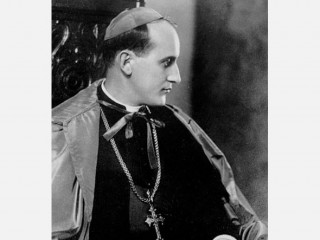
Alojzije Stepinac biography
Date of birth : 1898-05-08
Date of death : 1960-02-10
Birthplace : Krašić, Croatia
Nationality : Croatian
Category : Historian personalities
Last modified : 2010-11-25
Credited as : Catholic cardinal, was Archbishop of Zagreb, nationalist and anti-communist
A fervent Croatian nationalist, Catholic, and anti-Communist, Alojzije Stepinac became a world-wide symbol of Roman Catholic resistance to Communism when he was imprisoned by the Communist regime of Yugoslavia in 1946.
Alojzije Aloysius Stepinac was born to a large prosperous peasant family in the village of Krašić, Croatia, about 40 miles from Zagreb, then a part of Austria-Hungary, on May 8, 1898. After completing high school, he was drafted into the Hungarian army in World War I. Wounded and captured by the Italians, he subsequently joined and fought with the Allied-sponsored Yugoslav Volunteer Corps at Salonika. By 1919 he had earned several decorations for valor and had attained the rank of second lieutenant.
After the war, Stepinac attended the University of Zagreb in the new state of Yugoslavia, and in 1924 he enrolled in the Gregorian University in Rome to prepare for the Roman Catholic priesthood. A brilliant student, he earned doctorates in philosophy and theology and was ordained a priest in 1930. He returned to Yugoslavia to serve as a parish priest in the slums of Zagreb. Thereafter, his rise in the church hierarchy was extremely rapid, propelled by his growing reputation for deep piety and capable administration as well as his friendship with Papal Secretary of State Eugenio Cardinal Pacelli, who was to become Pope Pius XII in 1939. Stepinac was appointed secretary to Archbishop Ante Bauer of Zagreb, then (in 1934) titular Archbishop of Nicope and co-adjutor to Bauer, and finally (in 1937) Archbishop of Zagreb. The new primate of Yugoslavia was one of the youngest archbishops in Roman Catholic history.
In 1941, when Yugoslavia fell before the attack of Nazi Germany, Croatia declared itself an independent state. In reality, it became a puppet ally of Germany under the fascist (Ustaša) regime of Ante Pavelić. Stepinac, a dedicated Croatian patriot, accepted the Pavelić government as the legitimate representative of Croatian aspirations to political self-determination. To the very last days of World War II he publicly exhorted his clergy as well as the Croatian masses to support and defend the Ustaša state. He himself accepted the post of Supreme Apostolic Vicar General of the Croatian army and became a member of the ruling Council of State. His other actions and attitudes are in dispute. His defenders insist that, unlike other prominent Croatian Catholic churchmen, and at great personal risk to himself, Stepinac denounced the barbarous Nazi racial theories and practices adopted by the Ustaši and that he conducted extensive relief work among Christian and Jewish war refugees, even hiding them in episcopal buildings. They also deny that he condoned the forced conversions of Orthodox Christians to Catholicism or the notorious massacres of many thousands of Serbs, Jews, Slovenes, and anti-fascist Croats.
At war's end Marshal Tito's partisans took control of a reunited Yugoslavia and set up a Communist state. In November 1945 Stepinac was arrested, then released, ostensibly at the order of Tito himself. In a pastoral letter, Stepinac openly denounced Communism. He adamantly refused to accept the new regime's secularization of education and the destruction of the Catholic Church's privileges and the nationalization of its property. In September 1946 he was arrested and charged with wartime collaboration with the fascist regimes of Germany, Italy, and the Ustaša, as well as other war crimes and crimes against the new Yugoslav state. In October 1946 he was found guilty by the Supreme Court at Zagreb and sentenced to the confiscation of all of his property, the loss of his civil rights for five years, and imprisonment at hard labor for 16 years in Lepoglava Prison. The Vatican promptly excommunicated all persons connected with his arrest and trial. The tall, ascetic prelate quickly became a world-wide symbol of the growing church-state conflict in the new Soviet satellites of Eastern Europe.
In prison, the sentence of hard labor was not enforced. Stepinac was permitted to live in modest but clean quarters, to receive books, and to perform religious services and take communion. When Tito broke with the Soviet bloc in 1948, Stepinac's imprisonment threatened to embarrass his attempts to improve Yugoslav relations with the West. Stepinac was, therefore, released in December 1951, but was forbidden to act as a bishop and restricted to his native village of Krašić. There he served as a simple parish priest to the local inhabitants, numbering about 400 persons. In November 1952 the Papacy announced Stepinac's long-awaited elevation to the rank of cardinal. The following month Yugoslavia, in return, severed diplomatic relations with the Vatican. Stepinac did not go to Rome to be invested as a Prince of the Church, knowing that he would not be permitted to return home by the Yugoslav government. He also refused to go abroad for treatment of a blood-clotting problem (polycythemia) from which he suffered after 1953. Two American physicians were, however, permitted to come to Yugoslavia to treat him and to operate to remove blood clots from his bloodstream. He died of a heart ailment complicated by pneumonia in Krašić on February 10, 1960. His tomb in Zagreb has since become a place of pilgrimage for Croatian nationalists.
Two widely-available books in English about Stepinac are both Catholic defenses of the prelate: Anthony H. O'Brien, Archbishop Stepinac, the Man and His Case (1947), and Richard Pattee, The Case of Cardinal Aloysius Stepinac (1953). The latter work consists mostly of a large number of documents bearing on the specific charges in the indictment against Stepinac. For a more balanced treatment of Stepinac as well as the Vatican's generally ambiguous attitude toward the Croatian fascist regime, see Fred Singleton, Twentieth-Century Yugoslavia (1976).
Alexander, Stella, The triple myth: a life of Archbishop Alojzije Stepinac, Boulder: East European Monographs; New York: Distributed by Columbia University Press, 1987.
















